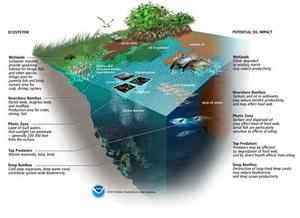Oil spillsAssessing the social, economic effects of Deepwater Horizon spill
Numerous studies are under way to determine the impacts of the Deepwater Horizon oil spill on the Gulf of Mexico, but the extent and severity of these impacts and the value of the resulting losses cannot fully be measured without considering the goods and services provided by the Gulf, says a new report from the National Research Council (NRC). The report offers an approach that could establish a more comprehensive understanding of the impacts and help inform options for restoration activities.

Oil spill impacts on several levels // Source: noaa.gov
Numerous studies are under way to determine the impacts of the Deepwater Horizon oil spill on the Gulf of Mexico, but the extent and severity of these impacts and the value of the resulting losses cannot fully be measured without considering the goods and services provided by the Gulf, says a new report from the National Research Council (NRC). The congressionally mandated report offers an approach that could establish a more comprehensive understanding of the impacts and help inform options for restoration activities.
A National Research Council release reports that currently, state and federal resource managers tasked with providing timely assessments of the damage use a process called the Natural Resources Damage Assessment, which is authorized under the Oil Pollution Act of 1990 and measures impacts in ecological terms such as the number of fish killed or acres of wetland destroyed. As a result, restoration activities usually focus on replacing individual resources. The impacts of environmental damage, however, extend beyond individual resources, the report says.
The people who live and work in the Gulf region depend on ecosystems for services such as food and fuel, flood and storm protection, and tourism and recreation. Damage to natural resources could impair these services, leading to social and economic impacts that may not be apparent from an assessment of environmental damage alone. In a 2011 interim report, the authoring committee introduced the concept of an ecosystem services approach to damage assessment, which requires an understanding of the environmental impacts from a disruption, the resulting decrease in goods and services, and the cost of those losses to individual communities and society at large.
In the final report, the committee illustrated how this approach might be applied to coastal wetlands, fisheries, marine mammals, and the deep sea — each of which provide key ecosystem services in the Gulf — and identified substantial differences among these case studies. For example, the amount and quality of available baseline data varies significantly among these ecosystem services. The case studies also demonstrate that some services are more easily monetized than others.
- Coastal wetlands. Approximately 1,100 linear miles of coastal wetland were affected by the Deepwater Horizon oil spill. In areas where roots survived the impact, little to no long-term impairment is expected. Where the oil destroyed vegetation and root systems, however, sediment erosion converted the marshland to open water. Since storm mitigation is directly related to the total
